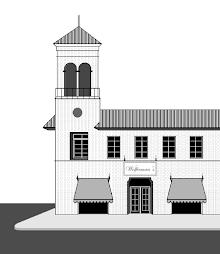In 2006, the Kettler Capitals IcePlex was completed. This facility, built on top of the mall's existing parking garage, serves as a practice arena for the NHL Washington Capitals.
Photo from Wikipedia / "RobDrur"
Alas, the trendy BALLSTON COMMON MALL began to falter. It was redeveloped between 2016 and 2019 and reemerged as BALLSTON QUARTER, a -you guessed it- mixed-use complex.
Graphic from Forest City Enterprises
A rendering of the BALLSTON QUARTER Wilson Boulevard facade.
Drawing from Forest City Enterprises
During the 2010s renovation, sections of the mall roof were removed, with open plazas -such as this- created.
Drawing from Forest City Enterprises
A northeastward view of the BALLSTON QUARTER complex. Its 7-level parking garage is front and center in the snapshot, as is the rooftop Iceplex.
Photo from Duane Lempke Photography
The food court in the old BALLSTON COMMON MALL was refurbished and retenanted. Today's Quarter Market features eleven food vendors.
Photo from https://www.coopercarry.com / Cooper Carry Architects
In 2019, the newly-remodeled BALLSTON QUARTER covered approximately 580,000 leasable square feet of retail, restaurant and entertainment. Origin Ballston, a third mall-connected high-rise, is a residential structure, with street level store space.
The one and only structure remaining from the old PARKINGTON CENTER is being redeveloped. Housing Macy's since 2006, the building is being replaced by a 16-story -553-unit- condo tower. It will house a grocery on its ground floor.
Drawing from Brookfield Properties
PARKINGTON CENTER
North Glebe Road and Wilson Boulevard
Arlington County, Virginia
The first post-war, suburban shopping complex in the Old Dominion was built on an 18-acre site, located 5.5 miles west of the US Capitol, in Arlington. The Hecht Company, then based in Washington, DC, announced plans for an Arlington branch in April 1950. Said store would anchor a single-level (with basement) shopping center. This would be built as a joint venture of the Hecht and Parkington Development Companies.
Construction was underway by October 1950. The complex was designed by Abbot, Merkt & Company, of New York City, with Kahn & Jacobs, also of New York City, acting as consulting architects.
A 5-level (250,000 square foot) Hecht's cost 6.5 million dollars to construct. The building had a facade of glazed green brick, red granux simulated stone and stainless steel. A large glass wall along the west side doubled as a message board. Hecht's opened for business on November 2, 1951 and was the largest suburban department store on the East Coast.
The facade of the adjacent shopping center consisted of crab orchard stone, Roman brick and stainless steel. There was a 5-level parking garage, with space for 2,500 autos. The first 3 hours cost 5 cents and 10 cents for each additional half hour. Eventually, all parking would be free-of-charge.
PARKINGTON CENTER -including Hecht's- encompassed approximately 430,800 leasable square feet. When fully realized, the 15 million dollar retail hub housed thirty store spaces. A 1-level (15,700 square foot) Giant Food became the first operational inline store on February 26, 1952. Hub Furniture, a 2-level (10,400 square foot) unit, held its grand opening on March 24, 1952. A 1-level (6,000 square foot) Crawford Clothes welcomed first shoppers on April 17th. The center's 2-level (36,300 square foot) J.G. McCrory 5 & 10 made its debut on June 30th.
A 2-level (29,100 square foot) W.T. Grant variety store was officially dedicated on August 7, 1952. William Thomas Grant, Grants founder and Chairman of the Board, was in attendance. By late 1952, PARKINGTON CENTER housed twenty stores and services. Newer tenants included Brentano's Books, Casual Corner ladies' wear, Holtzman & Platt Restaurant & Delicatessen and Walgreen Drug.
In July 1952, the Parkington Development Corporation sold their interest in the shopping center to the Mutual Life Insurance Company of New York. This involved the 2.2-acre site occupied by Hecht's. In February 1959, May Department Stores acquired the Hecht Company. Stores continued to operate under the Hecht's nameplate.
In August 1965, May Department Stores acquired the land that the PARKINGTON Hecht's was built on. At this time, the entire shopping complex covered approximately 570,000 leasable square feet. Operational stores included Peoples Drug (in the old Walgreens space), Edwards Shoe Stores, Leland's Watch Repair and a freestanding Hecht Company Tire Center.
The PARKINGTON McCrory's closed and was replaced by J.C. Penney, who opened a softlines & catalog store on May 1, 1974. Heavy rail transit was extended to the vicinity of the shopping hub on December 1, 1979. On this day, the 3-route-mile, Court House-to-Ballston Orange Line Metro extension began revenue service.
By the late '70s, PARKINGTON CENTER had been usurped by newer and larger shopping centers in its trade area. These included SEVEN CORNERS CENTER (1956) {2.2 miles southwest, in Fairfax County}, LANDMARK CENTER (1965) {4.5 miles south, in Alexandria} and -especially- TYSONS CORNER CENTER (1968) {in Fairfax County}.
In 1979, PARKINGTON CENTER was owned and operated by May Shopping Centers, a mall-building subsidiary of May Department Stores. A modest renovation and expansion was proposed. In May 1982, the Arlington County Board approved a General Land Use Plan for said renovation. The original proposal had been substantially revised. In May 1983, a joint venture was formed between Arlington County, May Shopping Centers and Cleveland's Forest City Enterprises. This entity would oversee construction of a new mall.
As part of the 42 million dollar project, the bulk of PARKINGTON CENTER was demolished. Only the Hecht's store was left standing. It was renovated, with Hecht Company corporate offices moved from the center city of Washington, DC to new quarters atop the department store. A 4-level, fully-enclosed shopping complex was also built; this designed by the Callison firm, of Seattle, and RTKL (Rogers, Taliaferro, Kostritsky, & Lamb) of Baltimore.
The structure contained 123 stores and services under its roof. The mall was connected with the 7-level Ballston Public Parking Garage, which had space for 2,900 autos. The 14-bay Commons Food Court occupied the basement (or Lower Concourse). Other features of the new mall included ceramic tile flooring, skylights, a glass-enclosed elevator and 8-story Ballston Common Office Center.
A contest was held to name the new shopping facility, with BALLSTON COMMON MALL chosen as the official moniker. A grand opening was held on October 20, 1986. Charter stores included Slade's Restaurant, La Vogue by Seiferts, CVS, International Bazaar and a 3-level (120,000 square foot) J.C. Penney.
About Ballston. It's a neighborhood at the intersection of Glebe Road and Wilson Boulevard. The area was originally known as Bailey's Crossroads. It morphed into Ball's Crossroads in the early 19th century. By 1900, a village named Central Ballston had been developed. Today, the Ballston area is at the western end of the Ballston-Rosslyn corridor; a DC-centric edge city.
Forest City Enterprises established full ownership of the BALLSTON COMMON MALL structure (excluding its Hecht's store) in 1993. In August 1997, Arlington County approved a mall expansion. This would add the 11-story Ballston Tower office building, 2-level (80,000 square foot) cinema and 29,300 square feet of retail and restaurant space.
The Regal Ballston Common Stadium 12 showed first features on June 18, 1999. Sit-down restaurants in the new addition included Rock Bottom Restaurant & Brewery and Romano's Macaroni Grill. The final facet of the turn-of-the-century expansion, the Ballston Tower building, opened in April 2001. BALLSTON COMMON MALL now contained 115 stores and services.
J.C. Penney had closed their BALLSTON COMMON store in April 2000. It was repurposed as a Hecht's Furniture Gallery, which opened for business in July 2003. Meanwhile, a face lift remodelling of mall common areas was completed in October 2002. This 2 million dollar project added new flooring, lighting and updated food court furniture. On September 9, 2006, all Hecht's stores were "Macy-ated."
At this time, construction of the (137,000 square foot) Kettler Capitals IcePlex was winding down. The facility, which was the new practice arena for the National Hockey League Washington Capitals franchise, was dedicated on November 11, 2006. In mid-2007, stores operating at BALLSTON COMMON MALL included B. Dalton Bookseller, Champs Sports, FYE (For Your Entertainment), Victoria's Secret, Wet Seal and the Sport & Health Club.
By the 2010s, the shopping hub was underperforming. There were approximately 100 tenants, but store rental receipts were not up to par. A major renovation and repositioning of the shopping complex was proposed. A joint venture was formed by Forest City Washington and Arlington County (Brisbane, Australia's Queensland Investment Corporation entered the joint venture in April 2016).
Forest City Washington bought the Macy's Furniture Gallery structure in September 2013, signifying the beginning of the renovation project. A new & improved BALLSTON CENTER would feature al fresco dining, dramatic 2-story retail facades, upper level terraces and an exterior street retail presence. The Arlington County Board approved the 300 million dollar redevelopment plan in November 2015. Atlanta-based Cooper Carry Architects would design the new mall. The bulk of BALLSTON COMMON MALL stores closed for good on May 31, 2016.
The vacant Macy's Furniture building was demolished in August. It would be replaced by the 22-story Origin Ballston tower, which housed 400 apartments and street level retail and restaurant space. The roof was torn off two sections of the enclosed shopping concourse, with mallways opened to the elements.
By May 2015, the official name of the prospective retail hub -BALLSTON CENTER- had morphed into BALLSTON QUARTER. Stores in the revitalized shopping venue began opening on November 16, 2018. The Regal Ballston Quarter, a revamping of the original 12-plex, showed first features on December 6, 2018. The first restaurant in the redevelopment, Punch Bowl Social, welcomed first diners on December 8th. At this time, Toronto-based Brookfield Properties acquired the assets of Forest City Enterprises and its subsidiary, Forest City Washington.
Vendors in the 18-bay Quarter Market food court opened for business in February 2019. These included Bartaco, Cucina Al Volo, Ice Cream Jubilee, Mi & Yu Noodle Bar, Swizzler and Timber Pizza Company. A mall-wide dedication was held on March 30, 2019.
Retail and entertainment facilities in BALLSTON QUARTER covered approximately 580,000 leasable square feet, with 761,400 square feet of office space in three mall-adjacent high rises. As of 2024, the shopping hub housed fifty-four stores and services. These included Macy's, Compass Coffee, CVS, Gossip ladies' wear, Grooming Store Barber Shop, Rewild Cards & Gifts, Onelife Fitness and the Bash boxing gym.
Sources:
The Washington Post
The New York Times
The Cleveland Plain Dealer
The Evening Star (Washington, DC)
The Daily Sun (Arlington, VA)
The Falls Church Echo (Falls Church, Virginia)
"Parkington Shopping Center Design" / R.H. Tatlow III / Abbott, Merkt & Company / 1952
https://arlingtonhistoricalsociety.org
https://www.arlingtonmagazine.com
http://forestcity.net (website on Internet Archive Wayback Machine)
http://ballston-common.com (website on Internet Archive Wayback Machine)
https://www.ballstonquarter.com
https://www.naiop.org / Commercial Real Estate Development Corporation
https://www.arlnow.com
https://www.prnewswire.com
https://www.qic.com.au / Queensland Investment Corporation
https://www.brookfieldproperties.com / Broofield Properties
https://www.ballstonquarter.com
https://uli.secure-platform.com / Urban Land Institute
https://thelandlawyers.com
https://www.shooshancompany.com










